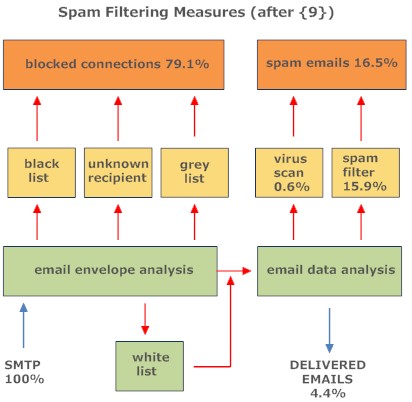 Section
Navigation
Section
Navigation
7. Technical Aspects
:Fundamental
7.1 Anatomy of Internet
7.2
Telecommunications
7.3 Wireless systems
7.4 Client Computers
7.5
Mobile Devices
7.6 Operating Systems
7.7 Computer Programs
7.8
Security: Applications
7.9 Browsers
7.10 Business Intelligence Systems
7.11 Cloud Computing
7.12
Databases
7.13 DTP Programs
7.14
eBook Readers
7.15 eMail Services
7.16 Expert Systems
7.17
Graphics Programs
7.18 Internet TV
7.19 Music & Video
7.20
Really Simple Syndication
7.21 Rich Media
7.22 Search Engines
7.23
Spreadsheets
7.24 Video Conferencing
7.25 Word Processing
:Corporate
Matters
7.26 Cluster Analysis
7.27 Neural Networks
7.28
Pricing Models
7.29 Realtime Systems
7.30 Regression Analysis
 7.15
Email & Instant Messaging Services
7.15
Email & Instant Messaging Services
Electronic mail is the most used service
of the Internet. 2010 saw 107 trillion emails sent from 1.88 billion email accounts.
{1} Electronic Mail
Email is provided either by servers (computers) dedicated to email messaging, or as one of a suite of programs run by the server. An email service is provided through:
1. A company's own
email server.
2. The web-hosting company.
3. Popular third-party suppliers
like Google, Yahoo
and Hotmail.
4. Companies
specializing in business email services, like fastmail,
usa.net, jangomail,
etc.
There are four types of email service:
1. Web-based email service:
operates like a webpage: useful when the local Internet Service Provider offers
a limited email service
2. POP email service: stores mail on a server, which
can be retrieved using any email client (program).
3. IMAP email service:
emails can be organized and filtered prior to retrieval from server. (POP and
IMAP are email protocols.) {2}
4. Email forwarding service: a program on the
email server that automatically redirects emails to a new email address.
Email is commonly in text or html (webpage) form and allows attachments of text, word, graphic, sound and video files, either as a standard service or with such programs as Email Effects, High Impact Email, Scrippy and V3Mail. The better services also provide spell-checking, virus scanning, spam protection, email formatting, and an electronic address book to store email addresses.
Mail can be powerfully encrypted with services like Hushmail and Izemail.
An email facility is easily added to webpages with a line of coding: mailto: name@company.com, or through forms, which call on a form-handling program written in some scripting language that is stored on the server (generally provided free by the web-hosting company).
Not to be confused with email is voicemail: a centralized system of stored telephone messages that can be retrieved later.

Spam
Spam, unsolicited email communication, not only wastes everyone's time but is a potential source of malware and other security breaches. Most countries have legislation in place, but prosecution has been difficult. {8} Large email providers spend over €1 million annually on spam filtering, and are generally successful, delivering under 5% of the emails sent to the servers. In decreasing order, these measures are used against spam: blacklisting, content filtering, sender authentication, URL blacklisting, graylisting, whitelisting, reputation system, checksum analysis, slowing sender's output and analysis of connection problems. Most contact the ISP sending spam. {9} Inexpensive software can reduce the problem further. {10}
Instant Messaging
Instant messaging programs are client software that call on software stored on the server. Instant messages are text messages sent in real time, i.e. the recipient receives the message with only a fraction of a second delay in transmission, and can type in a reply equally quickly. Popular programs are Windows Live Messenger, Google's Talk, Yahoo Messenger and Skype.
Instant Messenger systems also allow photos and audio clips to be inserted. More advanced instant messaging software also provides live voice or video calling.Online Chat is the broader category of instant messaging, and one that allows communication between several users in an often anonymous, multi-user environment. Several billion online chat/instant messaging accounts are in existence today. Online is used by customer and technical support to provide a quicker and more friendly service. Popular software includes Pidgin, Trillian and AIM.
 Questions
Questions
1. What is an email service, and how is it supplied?
2. Briefly describe
the four types of email service. What protocols are involved?
3. How can
email be made more secure? Compare three such services found by an Internet search.
4. What is instant messaging and online chat? What are their commercial applications?
 Sources
and Further Reading
Sources
and Further Reading
1. 107 trillion Emails Sent Worldwide
in 2010. TechAlphabet.
2. Types of Email Service. EmailAddresses
Good listings of services, also in non-English languages.
3. Top 18
Free Email Services. About.Com.
Brief but informative listing.
4. Ten Top Business Solutions for Email Service
Providers Named by StreamSend. TMC.Net.
What business email services should provide.
5. Instant messaging.
Wikipedia.
Technical article, with listing of the more popular services.
6. Comparison
of instant messaging clients. Wikipedia.
An extensive comparison by features, operating system and protocols.
7. Voicemail.
Wikipedia.
A solid, technical account: history of development and how the service works.
8. The Online Guide to Spam Email! AntiSpamSoftware.
Advertising antispam software but useful.
9. Anti-spam activities.
ENISA.
2009. European fight against spam: legislation and survey findings.
10. Spam
Filter Review. TopTenReviews.
2011. Inexpensive solutions.